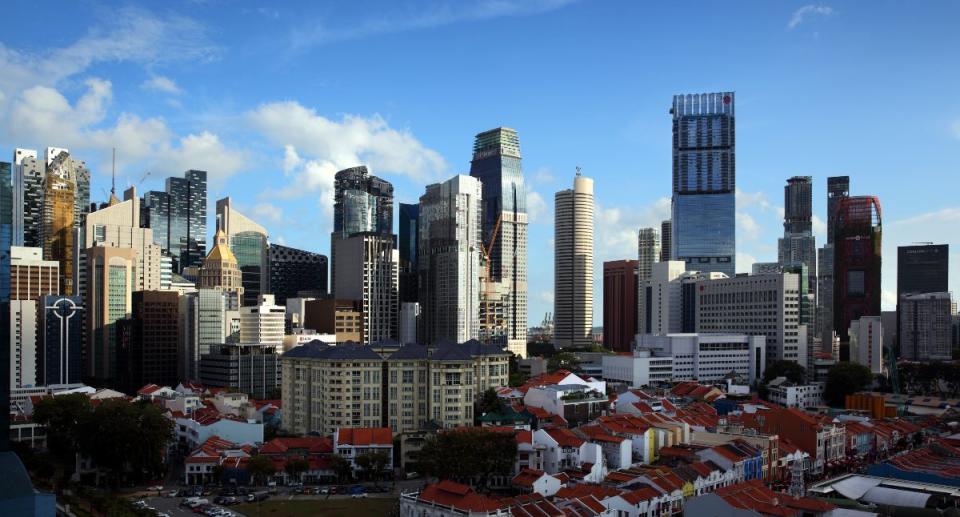IMF keeps Singapore’s 2024 GDP growth forecast at 2.1%, trims 2025 outlook slightly

For the current year, the IMF expects Asia and Asean to post GDP growth of 4.5% and 4.6% respectively.
The International Monetary Fund (IMF) is keeping its 2024 growth forecast for Singapore unchanged at 2.1%, despite the country’s GDP growth coming in 0.1 percentage points (ppt) higher than its previous forecast in October 2023.
For the current year, the IMF expects Asia and Asean to post GDP growth of 4.5% and 4.6% respectively. The IMF’s Asia growth forecast is 0.3 ppt higher than its last forecast six months ago, while its Asean forecast is unchanged.
In addition, the IMF has trimmed its 2025 GDP growth forecast for Singapore by 0.2 ppt to 2.3%, even as it maintains its 2025 Asia and Asean forecasts at 4.3% and 4.8% respectively.
The outlook for the Asia Pacific has brightened, even as the region is marked by both resilient growth and rapid disinflation, says Krishna Srinivasan, director of the Asia and Pacific Department at the IMF. “Growth is better than previously projected but will slow from 5% in 2023 to 4.5% in 2024. The region remains inherently dynamic and accounts for about 60% of global growth.”
Speaking at the release of the IMF’s latest regional economic outlook for the Asia Pacific on April 30, Srinivasan warned of disinflation throughout the region.
In Australia and New Zealand, disinflation remains above target, he adds. In emerging markets and Japan, it is at or close to central bank targets. In China and Thailand, however, there are deflation risks, according to Srinivasan.
China and fragmentation
In China, the deepening of the property sector downturn marred the rebound after the country’s post-pandemic reopening in early 2023, says Srinivasan. “Even so, the economy grew by 5.2% in 2023, more than we previously forecast. Fiscal stimulus enacted last October and in March helped mitigate the impact of declining manufacturing activity and sluggish services.”
The IMF has raised its 2024 growth estimate for China to 4.6%, up 0.4 ppt. China’s 1Q2024 growth came in “stronger than expected”, notes Srinivasan, and this forecast “may be revised upward”.
China is a source of both upside and downside risks, he adds. “Policies aimed at addressing stresses in the property sector and to boost domestic demand will both help China and the region. But sectoral policies contributing to excess capacity will hurt China and the region.”
Geoeconomic fragmentation remains a “significant risk”, according to Srinivasan.
One of the biggest risks for Asia’s economy is a protracted property sector correction in China, he says. This would weaken demand and could increase the odds of sustained deflation, he adds, with direct trade spillovers and falling export prices from China affecting the region.
This means China’s policy response matters — for both itself and the entire region, says Srinivasan. “A policy package that accelerates the exit of nonviable property developers, promotes the completion of housing projects and manages debt risks of local governments would boost confidence, support demand and help the economy reflate.”
In contrast, policies that boost supply, such as investment subsidies to specific companies and industries, would worsen overcapacity, he adds. This would reinforce deflationary pressures and potentially provoke trade frictions.
Ever more trade-restricting policies are being implemented, both in Asia and elsewhere, notes Srinivasan. “Reinforcing frictions would be a dismal outcome for a region that has benefitted so much from trade openness.”
One outcome is an inefficient lengthening of supply chains, as trade is channelled through third countries, he adds. “Global conflict poses additional risks to trade, as evidenced by the re-routing of ships around Africa to avoid the Red Sea, which raises shipment costs. Pacific Island countries are especially affected, as they are highly dependent on imports and poorly integrated into global shipping networks.”
Don’t depend on Fed
According to Srinivasan, Asian central banks should continue to focus “firmly on domestic price stability”, and they should avoid making policy decisions “overly dependent” on anticipated interest rate moves by the US Federal Reserve.
Srinivasan says Asian countries are “well-placed” to cope with exchange rate movements, and should continue to allow the exchange rate to act as a buffer against shocks.
At the same time, Asian governments need to pursue policies to reduce debt and deficits with “greater urgency”, says Srinivasan. He sounds a warning about rising debt levels, which are set to stay higher than pre-pandemic times.
“Progress last year fell behind what IMF staff had originally projected. Our forecasts show that on current fiscal plans, debt ratios would stabilise for most economies, provided governments underpin these plans with concrete policies and follow through on them. But even then, debt would remain significantly higher than it was before the pandemic,” he adds.
Governments face an “urgent priority” to streamline expenditures and raise more revenue, says Srinivasan. “Having to pay less on debt would eventually free up room in the budget for spending on development needs, social safety nets and climate mitigation and adaptation.”
See Also:
Click here to stay updated with the Latest Business & Investment News in Singapore
Market-watchers expect Singapore’s GDP to grow by 2.4% in 2024: MAS survey
Analysts mostly keep Singapore’s GDP estimates for 2024 despite softer-than-estimated 4Q2023 growth
Get in-depth insights from our expert contributors, and dive into financial and economic trends